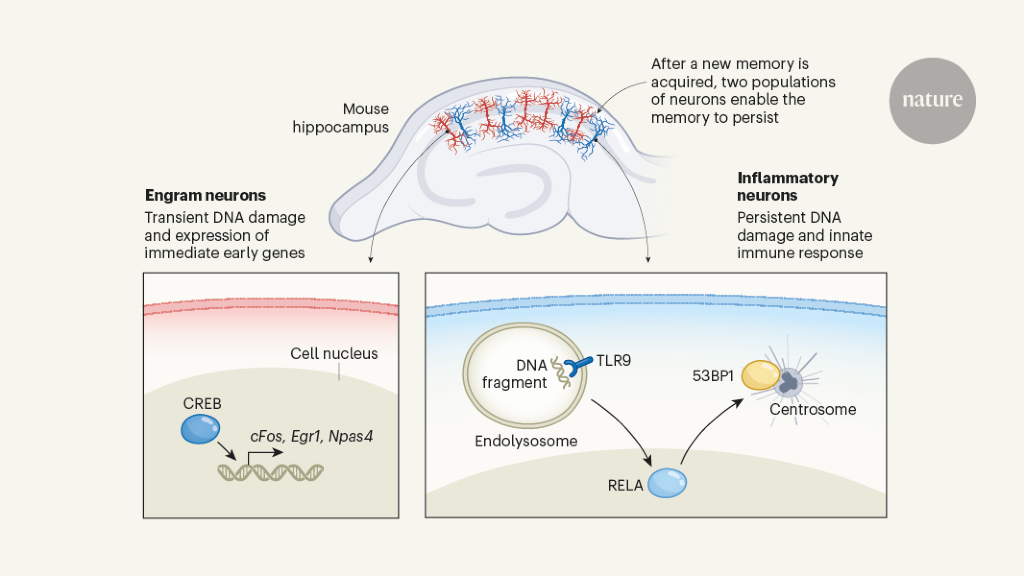The Role of Innate Neuronal Immunity in Memory Persistence
Core Concepts
Neuroscientists uncover molecular mechanisms crucial for memory persistence in neurons.
Abstract
The content delves into the mystery of how memories last, drawing parallels to Salvador Dalí's works. It highlights the increasing relevance of memory-related conditions like Alzheimer's disease and dementia in an aging population. The focus is on the essential molecular mechanisms described by Jovasevic and colleagues in Nature that contribute to memory persistence in neurons.
Innate immunity in neurons makes memories persist
Stats
"Writing in Nature, Jovasevic and colleagues1 fit a crucial piece into this puzzle by describing molecular mechanisms that are essential for memory and mark a new population of neurons."
Quotes
"Writing in Nature, Jovasevic and colleagues1 fit a crucial piece into this puzzle by describing molecular mechanisms that are essential for memory and mark a new population of neurons."
Key Insights Distilled From
by Benjamin A. ... at www.nature.com 03-27-2024
https://www.nature.com/articles/d41586-024-00679-4
Deeper Inquiries
How do advancements in understanding memory mechanisms impact potential treatments for memory-related conditions?
Advancements in understanding memory mechanisms have a significant impact on potential treatments for memory-related conditions. By uncovering the molecular mechanisms that underlie memory formation, consolidation, and retrieval, researchers can develop targeted interventions to enhance memory function or mitigate memory deficits. For example, identifying specific proteins or signaling pathways involved in memory processes can lead to the development of drugs that modulate these targets to improve memory function. Additionally, understanding how memories persist over time can inform strategies to prevent memory loss in conditions like Alzheimer's disease. By elucidating the intricate processes involved in memory formation and maintenance, scientists can design more effective therapies that target the root causes of memory-related conditions.
What are the potential limitations or criticisms of focusing on molecular mechanisms in memory research?
While focusing on molecular mechanisms in memory research has yielded valuable insights, there are potential limitations and criticisms to consider. One limitation is the reductionist nature of studying memory at the molecular level, which may oversimplify the complex interactions between different brain regions and neural circuits involved in memory processes. Critics argue that solely focusing on molecular mechanisms may neglect the broader context in which memories are formed, such as the role of emotions, experiences, and environmental factors. Additionally, the emphasis on molecular mechanisms may lead to a narrow view of memory that overlooks the dynamic and multifaceted nature of human cognition. It is essential for researchers to integrate molecular findings with other levels of analysis, such as behavioral studies and neuroimaging, to gain a comprehensive understanding of memory.
How can artistic interpretations of memory, like Dalí's works, influence scientific exploration in neuroscience?
Artistic interpretations of memory, such as Salvador Dalí's works, can influence scientific exploration in neuroscience by providing unique perspectives and inspiring creativity in researchers. Dalí's surrealistic representations of memory in paintings like The Persistence of Memory and The Disintegration of the Persistence of Memory offer visual metaphors that challenge conventional notions of time, space, and perception. These artistic interpretations can spark new ideas and hypotheses in neuroscience by encouraging scientists to think outside the box and consider unconventional explanations for memory phenomena. By engaging with art, researchers may gain fresh insights into the subjective experience of memory and its representation in the brain, leading to innovative approaches in studying memory processes. Artistic interpretations of memory can serve as a source of inspiration and a catalyst for interdisciplinary collaborations between artists and scientists, enriching the exploration of memory in neuroscience.
0
